Being immersed in the fitness industry provides me with a ton of different opportunities to experience different techniques, methodologies, and products. I recently had the privilege of a...
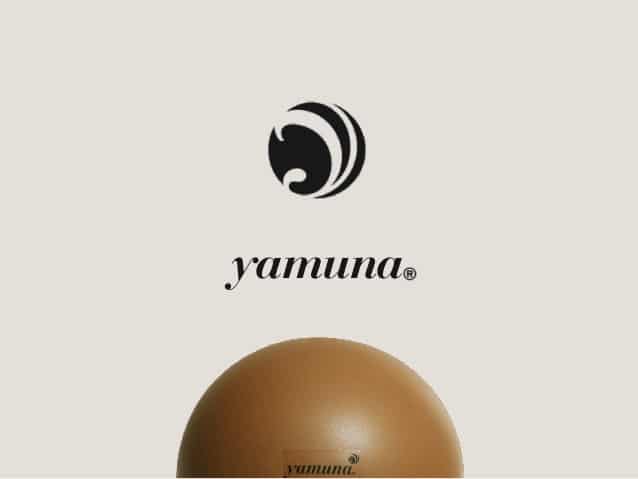

Being immersed in the fitness industry provides me with a ton of different opportunities to experience different techniques, methodologies, and products. I recently had the privilege of a...
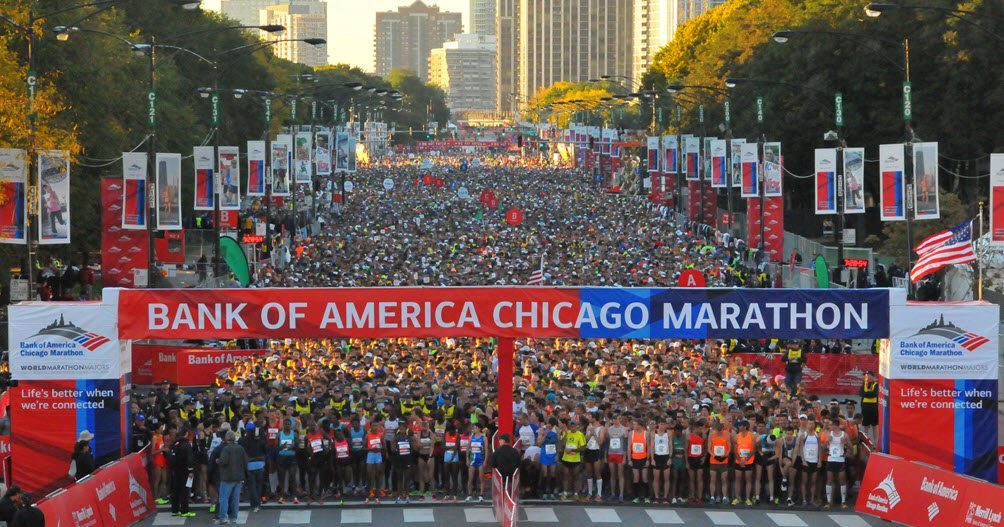
Leading up to the Chicago Marathon 2016 The Chicago Marathon provides an excellent course, plenty of support and, for me, a chance to visit home for a few days. It was no different for me this...
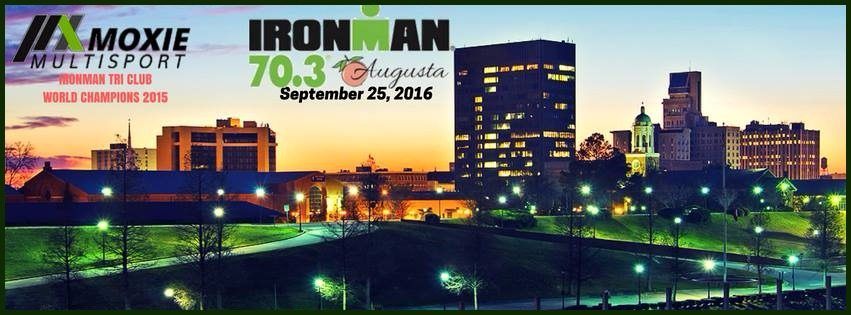
September 25 was going to be my day. The Ironman Augusta 70.3 triathlon was finally here. The race I had been training so hard for on one of my favorite courses. It was four-and-a-half months...
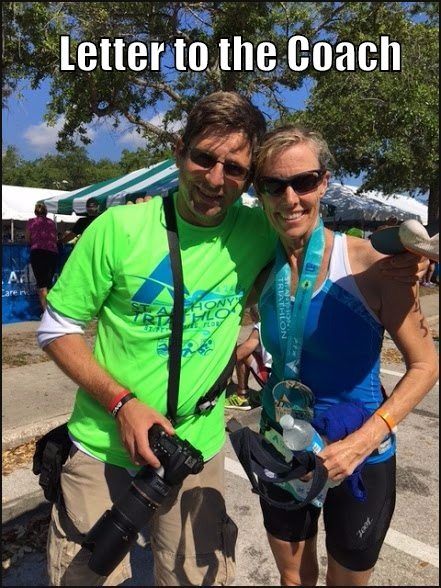
I have been an endurance coach for some time now. Once in a while, I receive an email from a client which chokes me up with pride. Today, I received one of those letters, so instead of sharing it...
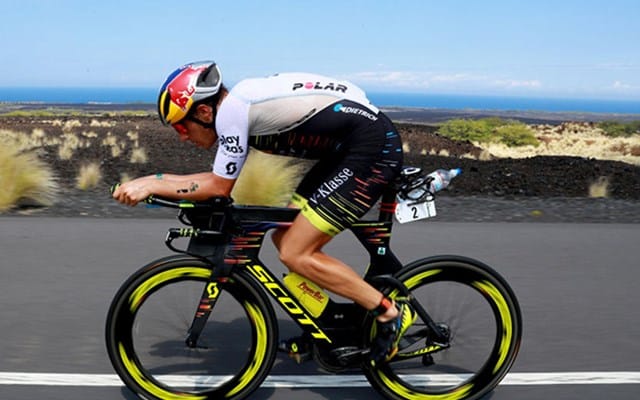
I found when looking for ways to get faster on the bike, is that there is so much information, from different coaches and experts, that it can be confusing and overwhelming. Personally, I...
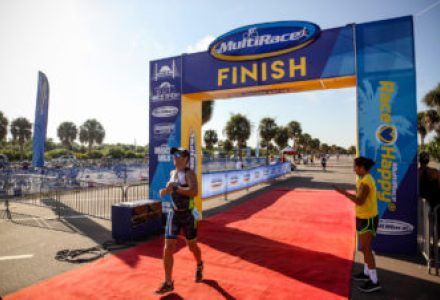
The previous post was a review of the FD3 Triathlon Series as if it was a product. Below you will find a more detailed account of my personal experiences during the race. Let me know in the...
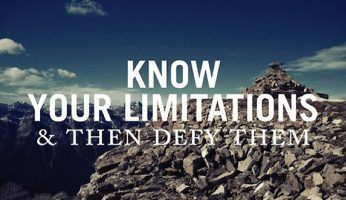
On Tuesdays and/or Thursdays, I will do my best to give one simple fitness, triathlon or running tip, trick or piece of information that will provide some value to in either helping you to become more efficient, prevent injury, increase performance, have more fun or at the minimum give a review of knowledge that might not have crossed your path in a some time.
I find myself observing other runners while running and sometimes just hanging out here in Tampa. Due to the weather here lending itself to year-round training, I have no shortage of material to choose from.
My coaching practice’s number one priority is form, technique and injury prevention, so I routinely use other runners, with my clients to reinforce the form training I have provided. (Sorry, Tampa runners. If you happen to pass by me with a client, most likely you have been observed and surveyed for comparative analysis.)
With all of my observations, the number one issue that I see are runners that sit in the bucket. Of course, the question most people ask is what does sitting in the bucket mean?
Basically, it’s when the glutes(or bum) are not in line with the torso. The body looks like an “L” from the torso to the hamstrings. Natural running which when learned is much easier, more efficient and greatly reduces impact on the joints. The torso hips, glutes and ankles form a straight line.
[table “2” not found /]
The interesting thing is, that running should be instinctual right? Unfortunately, not anymore. Sociological factors have played into our bodies to a point where most Americans, cannot just decide to take up running without going through periods of injury.
For example, sitting at a desk all day will tighten the hip flexors so that it becomes extremely difficult to push the hips under the torso. The same thing is evident for playing video games on the couch for long periods of time.
The figure on the left is actually still a lot better than I have noticed out and about. The torso is still tall and the chest is still has a little bit of lean to it causing forward motion. A lot of runners I notice, sit in the bucket and lean back. What is this doing? Basically, gravity is working against the runner. The objective is forward motion but the glutes and the torso are sitting back, so in essence, the body and gravity are working against itself.
Another perception you will see is the heel strike of the runner. When that heel strikes the ground the impact reverberates all the way from the ankle through the legs, spine, neck shoulders and head. This is where most of the injuries take place.
By simply starting to incorporate, tilting the hips under the torso and leaning from the ankles instead of the waste, the body will start allowing gravity to be used instead of the legs as the sole source of momentum. Suddenly, the feet are striking the ground underneath the center of gravity and only the calf down to the metatarsals absorb the majority of the impact from the ground.
I continue to instill in my clients, running is powered by the core, not the legs. Use gravity as momentum and allow the legs to just go for the ride. To remain consistent, the core must be strengthened and hip flexors stretched to keep the glutes from returning to the bucket.
There are many techniques to help modify the behavior to allow for an efficient, safe and effective change of form. All it takes it the will to want to change and get better and you will.
The #1 tip – get out of the bucket.
Are you running in the bucket?
Did this information shed some light on any area of your running that might be in need of improvement?
Carpe Vitam!
(Seize Life!)
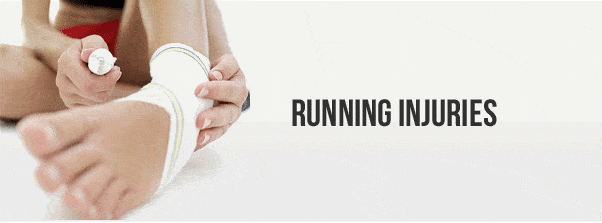
I believe I have started to write this post on injuries, a number of times, trying to be as clear as possible without seeming conceited or that the information I am giving is absolute. That being said I am giving this disclaimer:
The information in this post comes from experience, my personal research and conversations with Physical Therapists, Bio-mechanical experts, Orthopedists and other athletes. I am not a physician or medical expert, so please take this information as opinion based on cognitive research. Also, there is an exception to every rule and another explanation. I do welcome comments that give constructive criticism, but I make mention to this disclaimer first.
You might be surprised to hear that there are only two reasons runners (and other athletes) get injured; accidents and imbalance. Accidents are obvious right? For example; rolling the 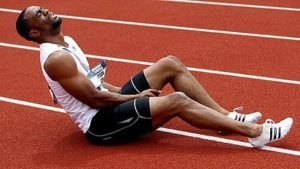 ankle stepping off a curb, falling, being hit by a bicycle, etc.
ankle stepping off a curb, falling, being hit by a bicycle, etc.
Imbalance will cover the why’s of the rest of the injuries. The human body is designed for every system to work in synergy, therefore when one piece of the puzzle is not operating a full capacity or efficiently, the other systems have to do more work. This is when the imbalance occurs.
When talking with Physical Therapists and Bio-mechanical experts I was shocked at some of the stories I heard. One story I heard was of a football player who was training, running 100s up and down the field carrying a ball. He had extended his shoulder just barely beyond its usual range of motion, and he ended up with severe pain in his opposite quadricep. “What?!!!!” was my initial reaction, however, I was then educated on the connective tissue (ligaments, tendons etc) which can be traced from the very top of our skull, down through our torso and into the extremities. Everything is connected.
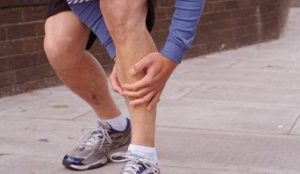
As another example, one of the most popular injuries for newer runners are the dreaded shin splints or medial tibial stress syndrome (MTSS).
Scientifically it is caused tiny micro tears of the fibers connecting the medial soleus fascia through the periosteum of the tibia where it inserts into the bone. Due to the soleus becoming so week that the constriction starts to bow the tibia. In more layman’s terms, the calf becomes so tight due to weakness and inflexibility, that the connective tissue pulls on the bone. (There is some physiological proof and complaints that more runners are getting shin splints and other injuries due to training in calf sleeves and other compression gear, but I will address this in another post.)
This same weakness, fatigue in the calf muscle can also cause another popular injury. Plantar Faciitis. In this case, instead of the connective tissue weakening through to the soleus is pulls on the plantar fascia causing inflammation which can be debilitating.
An injury can be traced either by the athlete themselves or by a professional to a point of imbalance. Most likely somewhere within the full spectrum of the athletes, body, behavior and, do I dear say it, attitude.
As a coach and trainer, my first rule, and one that I increasingly live by, is “Do no harm.” Therefore, I am always asking questions starting at a high level and continuing to get more specific. (The examples below are catered more toward running, but can be used in any sport.)
There are definitely more questions I ask, however, I think these examples give a good idea of why balance is so important.
The term “overuse” is being used quite a bit, but what is it? It’s an imbalance of planning or lacking thereof. Tracing Injuries is completed from the highest level which would be the training plan, all the way down to the balance of strength and flexibility within the connective tissue of the body. Personally, I think it is amazing that on one hand our bodies can endure a lot, but if we don’t notice those little weaknesses, it will create an imbalance that could cause and injury that may or may not keep us from doing what we love most.
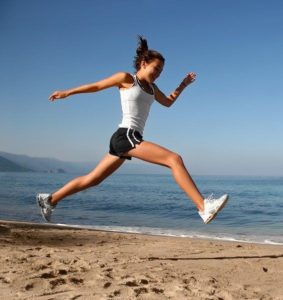
Balanced Plan -> Period -> Weeks -> Workouts -> Balanced Form -> Body -> Mind
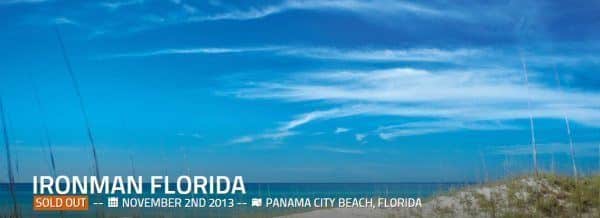
For a long time, it has been called the Granddaddy of all endurance events, the Ironman triathlon. A 2.4-mile swim, 112-mile bike and a 26.2-mile run done consecutively in the same day. Of course, nowadays, double, triple, and even deca Ironman distance triathlons are becoming more and more popular, as well as 24, 48 and even 72-hour mud and obstacle run challenges. If you are calling me crazy for doing my second Ironman, I can introduce you to at least a few people who do challenges that make Ironman look like a game of hopscotch. (Yes, Matt “UltraIronBeast” Dolitsky, you are one of those.)
This competition for me was a learning experience in overcoming obstacles, most of them mental. I did not PR, or even come close, but I now understand completely the quote, “The mind will quite 100 times before the body does.”
Pre-Race

Pete Amedure, Kari Eichen, Kat Ward, Jamie Breibart and myself all decided to drive up Wednesday morning in order to get acclimated to the environment and eliminate and reasons for not being prepared for Saturday’s race. Pete, Kari and I were in my car and had a great time on the way up. Of course, there was a stop at the Huddle House in Perry Florida where we ate and laughed to a point where I spaced out and left my phone, and didn’t realize it until we were half-an-hour from Panama City Beach. It didn’t help that I was in the middle of contracts and had all my recruiters contacting me about interviews and new opportunities. (I ended up remedying this by sending FedEx to the restaurant and delivering it to our hotel. In the meantime, Google Voice was a tremendous help.)
We arrived at the Laketown Wharf complex where we stayed in a luxurious three bedroom, three bath condominium, with a beautiful view of the gulf. I give this hotel/condo complex four stars. It had everything needed including a nightly water and light show that rivals the Bellagio in Las Vegas. Well, not really, but it was a fun amenity. The condos all have a full kitchen, with dishes, glasses, silverware, pots and pans, coffee maker, and a full-size refrigerator. Everything needed for the athlete, and spectathletes, to remove all those pressures of nutrition, and early morning breakfasts. The area also has plenty of great restaurants for good eating as well.
Afterward, we walked the quarter mile to athlete check-in to receive our chip, bibs, bags, and swag. I was a little disappointed in the swag this year. Last year they gave out beautiful TYR transition backpacks, but this year it was a very inferior white backpack that looks like it will fall apart. Jamie’s actually did, so they gave her a replacement immediately. The expo was about twice the size that it was last year, with a host of new vendors. Verizon was displaying their goods, as they were the tracking sponsor this year, along with Newton, Fit2Run, a local bike shop and a bunch of the regulars. Refuel was there, talking about Chocolate Milk, so I did create a video with them talking about the benefits of it. I will share that link on Twitter when I receive it. It should be good for a couple of laughs.
After that, we spent the next couple of days, taking in the aura of Ironman, preparing and eating. Eating was a non-stop event for us. I knew from experience that immense calories were going to be needed in order to be comfortable on the course, so I encouraged our team to keep eating as I did myself.
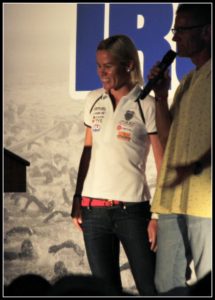 Thursday night was the athlete welcome dinner, and I was almost embarrassed. My recollection of the 2011 athlete dinner was so wonderful, that I really talked it up and encouraged Pete, Jamie, and Kari to come. Jamie decided not to go, but I was so excited for Pete and Kari to be there I couldn’t contain my emotions. Unfortunately, I was sort of let down. It seemed unorganized and hurried. Yes, my favorite pro-triathlete and world champion Mirinda Carfrae was interviewed on stage, so that was great, but the rest of it was about charities and a couple of athletes overcoming their own obstacles. There were video presentations about a woman who was competing for her husband who died the year earlier while training, and a quadriplegic who was competing to show the world that anyone could do anything if they just challenged themselves.
Thursday night was the athlete welcome dinner, and I was almost embarrassed. My recollection of the 2011 athlete dinner was so wonderful, that I really talked it up and encouraged Pete, Jamie, and Kari to come. Jamie decided not to go, but I was so excited for Pete and Kari to be there I couldn’t contain my emotions. Unfortunately, I was sort of let down. It seemed unorganized and hurried. Yes, my favorite pro-triathlete and world champion Mirinda Carfrae was interviewed on stage, so that was great, but the rest of it was about charities and a couple of athletes overcoming their own obstacles. There were video presentations about a woman who was competing for her husband who died the year earlier while training, and a quadriplegic who was competing to show the world that anyone could do anything if they just challenged themselves.
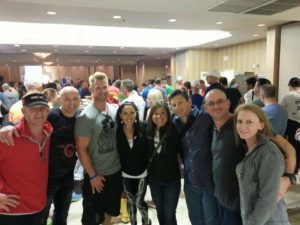 Yes, their stories were inspiring but I just felt like it was too much and way too long. In 2011 the presentations were balanced between the negative and the positive inspiring stories and we even had an athlete briefing by the race director all in the span of 90 minutes. It held the attention of every athlete to a point where the announcer almost didn’t need the microphone. This time, a good portion of the athletes conversed right through all the presentations to a point where it was hard to hear the MC with a microphone. I felt like I let my friend Pete down to a point where I was apologizing so much on the walk back I became annoying. Sorry, Pete and Kari.
Yes, their stories were inspiring but I just felt like it was too much and way too long. In 2011 the presentations were balanced between the negative and the positive inspiring stories and we even had an athlete briefing by the race director all in the span of 90 minutes. It held the attention of every athlete to a point where the announcer almost didn’t need the microphone. This time, a good portion of the athletes conversed right through all the presentations to a point where it was hard to hear the MC with a microphone. I felt like I let my friend Pete down to a point where I was apologizing so much on the walk back I became annoying. Sorry, Pete and Kari.
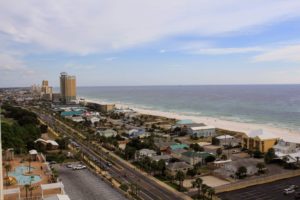 Friday, the anxiety hit like a ton of bricks. You couldn’t cut the tension in the condo with a Ginsu, serrated edge knife. We ate breakfast and then headed down to the beach to get in the water with our wetsuits. The waves sets were barreling to the shore with such force that the red, “no-swimming”, flag was flown, but we knew we needed to at least get in the water for a few minutes just to test out our goggles and our wetsuits. Surprising enough, even with the force of the waves, I thought I became a little more confident. I was able to stay on the surface of the water, and I practiced duck diving through the waves instead of trying to swim over them. I really thought I may have a chance of being faster out of the water than I thought.
Friday, the anxiety hit like a ton of bricks. You couldn’t cut the tension in the condo with a Ginsu, serrated edge knife. We ate breakfast and then headed down to the beach to get in the water with our wetsuits. The waves sets were barreling to the shore with such force that the red, “no-swimming”, flag was flown, but we knew we needed to at least get in the water for a few minutes just to test out our goggles and our wetsuits. Surprising enough, even with the force of the waves, I thought I became a little more confident. I was able to stay on the surface of the water, and I practiced duck diving through the waves instead of trying to swim over them. I really thought I may have a chance of being faster out of the water than I thought.
Afterward, we talked through our transition plans to double check our gear,  checked to make sure our bikes were ready to go and proceeded to transition to check-in everything. We had decided to try and wait out the rain, but unfortunately, I had a phone interview which had the chance of exceeding beyond the time check-in would close, so we walked down in the rain. The line was so long, I was going to be cutting it very close, so afterward, I ran back to the hotel. On the way back, I dropped my phone and cracked the screen. Yes, I had the phone back in my hands all of two hours and I dropped it. I have never broken a phone before, ever, and here I had two phone interviews and I cracked the screen. I was lucky enough that the phone still worked with voice recognition and a little effort, so the two interviews scheduled went off without any problems and I confirmed them both for second interviews as well.
checked to make sure our bikes were ready to go and proceeded to transition to check-in everything. We had decided to try and wait out the rain, but unfortunately, I had a phone interview which had the chance of exceeding beyond the time check-in would close, so we walked down in the rain. The line was so long, I was going to be cutting it very close, so afterward, I ran back to the hotel. On the way back, I dropped my phone and cracked the screen. Yes, I had the phone back in my hands all of two hours and I dropped it. I have never broken a phone before, ever, and here I had two phone interviews and I cracked the screen. I was lucky enough that the phone still worked with voice recognition and a little effort, so the two interviews scheduled went off without any problems and I confirmed them both for second interviews as well.
That night we had a good dinner at the Wicked Wheel and we were all in bed around 9 pm ready to take on the Ironman.
Race Day
As predicted, the night before was restless but I did end up sleeping a good 4-5 hours before the alarm went off. As planned we dressed in sweats, grabbed our “Special Needs” bags, nutrition for the bike, and headed to transition around 4:30 am. We were body marked, checked our bikes, dropped our bags, and then headed back to try and leisurely eat breakfast, and dress for the race. Kari cooked eggs and turkey bacon, I cooked oatmeal and we all hung out for a while and tried to prepare ourselves with our loved ones. It was kind of surreal. I remembered these moments from the first time I competed in this race, but it still seemed like it was all new again.
We dressed, pulled on our wetsuits halfway, hugged and headed for the start line. We walked  with Kari, Kim, and Danny down to the start, but athletes had to enter separately than spectators, so when we finally hit the beach we couldn’t find them. I really wanted to see them all before the start, but I knew I would be ok if I didn’t, but Kari had Pete’s goggles in her bag, so now it became imperative that we find them. We walked over trying to find them, so when it came to a point where we had no time left, we dropped our stuff and proceeded to button up our wetsuits and prepare to go under the arch. It was at that moment, our party found us. Talk about cutting it close. We hugged, gut our well wishes, wished each other luck and headed into the mass of athletes preparing for the start.
with Kari, Kim, and Danny down to the start, but athletes had to enter separately than spectators, so when we finally hit the beach we couldn’t find them. I really wanted to see them all before the start, but I knew I would be ok if I didn’t, but Kari had Pete’s goggles in her bag, so now it became imperative that we find them. We walked over trying to find them, so when it came to a point where we had no time left, we dropped our stuff and proceeded to button up our wetsuits and prepare to go under the arch. It was at that moment, our party found us. Talk about cutting it close. We hugged, gut our well wishes, wished each other luck and headed into the mass of athletes preparing for the start.
This year was a little different as signs were being held up with expected times for the swim. It could be compared to pace groups commonly found in road races except instead of going deep from a start line this went wide along the shore with the idea that if the slower swimmers would be the widest from the buoys and would fall in behind the faster ones. This was thought to bring down the chaos of a mass swim start, but for me, it was worse. I have been in comparable rough water, hit, kicked and swam over before and I always kept on swimming no matter what, but this time I was kicked so many times with the last time throwing my goggles from my face. It took me a few minutes to find them floating away from me, but I was able to put them back without too much trouble.
When I finished my first loop, the clock said 1:11 which was very slow. I thought I should be able to make up at least three minutes on the second loop, so I shouldn’t be in any danger of not making the 2:20 cutoff. I found a rhythm and just kept swimming, but I veered to the left of buoys and to keep correcting my course. When I made the turn for the straightaway to the swim finish, I glanced at my wrist to check my Garmin to see how much time I had left, and it was gone. Not only could I not find out what I needed to cross the swim finish, I wasn’t going to know how fast I would bike, or run. I wouldn’t know when to take my nutrition or even what time it was.
 Three buoys from the end I ended up with a paddle boarder on the left of me and jet ski on the right. The paddleboarder kept yelling the time I had left. “You have 8 minutes. You got this just keep going.” I have to admit, the idea of a DNF crossed my mind and it did not scare me. I thought to myself “would it really be the end o the world.” I would be able to support Pete, Jamie, and Kat and I wouldn’t have to worry about biking 112 miles, chafing, nutrition, none of it. Of course, I wouldn’t get to cross that finish line and I would feel like a failure and that is what really scared me. It wasn’t the disappointment of my friends or even my family, it was the disappointment I would have in myself. That never-ending coulda, woulda, shoulda would really haunt me, so I sped up and went as hard as I could. The waves after the sandbar helped and even though I got caught up in the rope tied to one of the lifeguard’s flotation device I was able to hit the beach at exactly 2:20 getting me over the timing mat at 2:20:08.
Three buoys from the end I ended up with a paddle boarder on the left of me and jet ski on the right. The paddleboarder kept yelling the time I had left. “You have 8 minutes. You got this just keep going.” I have to admit, the idea of a DNF crossed my mind and it did not scare me. I thought to myself “would it really be the end o the world.” I would be able to support Pete, Jamie, and Kat and I wouldn’t have to worry about biking 112 miles, chafing, nutrition, none of it. Of course, I wouldn’t get to cross that finish line and I would feel like a failure and that is what really scared me. It wasn’t the disappointment of my friends or even my family, it was the disappointment I would have in myself. That never-ending coulda, woulda, shoulda would really haunt me, so I sped up and went as hard as I could. The waves after the sandbar helped and even though I got caught up in the rope tied to one of the lifeguard’s flotation device I was able to hit the beach at exactly 2:20 getting me over the timing mat at 2:20:08.
I don’t mind stating that I was exhausted. I have stated it time and time again, that I am not even a good swimmer, but this really put it in perspective.
I ran into transition and the volunteers stated I had eight minutes to cross the bike mat, so they hurried me into my bib and jersey I was using for the bike, put on my helmet and shoes and rushed me out into transition to grab my bike. I crossed and headed out on my 112-mile journey.
My lungs were screaming and my stomach was churning, but I just kept going. I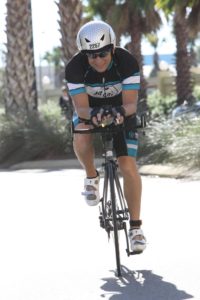 passed the mile 10 marker and about, what I estimate was around the 12-13 mile mark, nausea started. I pulled over to the side of the road and vomited sea water over the guardrail. Unfortunately, I have what is called a vasovagal response to vomiting, which basically means I pass out cold. I woke up, splayed out on the side of the road with the sun shining in my eyes. It took a while to get my wits and balance in order to get back on my bike. I continued slowly with the thoughts of turning around and just ending it. Who would blame me? I became sick on the bike, no one would care. With my stomach still churning and my head spinning I decided I would go to the twenty-mile marker and if I didn’t feel better I would turn around. The earlier thoughts I had of a DNF plagued me again and when I saw the 20-mile sign, I was still feeling sick, but better than I did. I took in some of the Isagenix mix I had in my bottles and decided to go on to the next marker, but it wasn’t more than a mile later I realized that if I turned around at the 30 mile mark, I would have biked 60 miles by the time I got back to the start. That’s when I knew I had it in me. It no longer was about time now it was about finishing.
passed the mile 10 marker and about, what I estimate was around the 12-13 mile mark, nausea started. I pulled over to the side of the road and vomited sea water over the guardrail. Unfortunately, I have what is called a vasovagal response to vomiting, which basically means I pass out cold. I woke up, splayed out on the side of the road with the sun shining in my eyes. It took a while to get my wits and balance in order to get back on my bike. I continued slowly with the thoughts of turning around and just ending it. Who would blame me? I became sick on the bike, no one would care. With my stomach still churning and my head spinning I decided I would go to the twenty-mile marker and if I didn’t feel better I would turn around. The earlier thoughts I had of a DNF plagued me again and when I saw the 20-mile sign, I was still feeling sick, but better than I did. I took in some of the Isagenix mix I had in my bottles and decided to go on to the next marker, but it wasn’t more than a mile later I realized that if I turned around at the 30 mile mark, I would have biked 60 miles by the time I got back to the start. That’s when I knew I had it in me. It no longer was about time now it was about finishing.
From that point on the bike ended up being uneventful. Sure, there were minor challenges. For instance, the wind picked up quite a bit, and of course, I still had no perception of time, except for when I asked, but I just put my head down and kept going.
Here is a little lesson learned while I was on the bike. As I mentioned the wind became a challenge during the bike, but I decided to wear an aero helmet and while I was in aero position and looked down, the wind became a little less a factor. I found myself being able to pick up a higher cadence. The minute I looked straight I could not only hear the wind, but I felt like someone had hit the breaks on my bike. Every article and person always said, one way and the cheapest way to become more aero was a helmet. They were right.
Being the last one out of the water did have one advantage. I wasn’t going to get passed. I was doing all the passing, and with each rider I passed, I felt a little bit of mental boost which helped a great deal. I rolled into transition in a little over 7 hours, which, in my estimation, had me on the side of the road for a little over 30 minutes. All-in-all it wasn’t actually that bad.
A volunteer grabbed my bike, I snatched my run gear bag and was greeted in the changing room by my friend, and client, Hugo Scavino. He helped me rid myself of the bib and bike jersey and don my shoes and hat. After a huge hug, I headed off onto the run course. I stopped briefly for words of encouragement, hugs and kisses from Kim, Kari, Maria and Anne, and off onto the course I went. I walked for about a quarter mile before I started running. I was kind of amazed. I felt like I was able to transition to my running legs a little easier than the Augusta 70.3 I competed in six weeks earlier. I hit the first aid station in about 1.5 miles and I was feeling pretty good. I formulated my plan of running from aid station to aid station and just walking while I was getting water and nutrition. This worked for the first loop.
 Pete and Jaime passed me at my mile 3 and their mile 10 and we shook hands and I motivated Pete with warning him I should not be able to catch him. Of course in the back of my mind, I was questioning if I could somehow make up 7 miles on him. Dave Nardoski caught up with me on his second loop, so I walked and chatted with him for a few minutes before I picked up the pace again. At mile 6 I saw Kat looking really strong and I yelled some encouragement to her as I passed. The halfway point for the first loop is in a park and I was feeling pretty good. I started doing the math in my head for what it would take to catch up to Pete and Jamie. The idea of the three of crossing together seemed surreal but possibly realistic. At mile 10 I saw Jamie and she had picked up the pace from Pete, and she looked really good. Obviously, the three of us crossing was most likely not going to happen unless I could really pick up some speed and Pete and I could catch her. A little while later I saw Pete again walking. We stopped for a minute and he told me that everything hurt. I gave him some encouragement and we parted. Just prior to the turnaround I found myself running next to Lew Hollander. Lew, is an 83-year-old, twenty-time Kona qualifier and finisher. He is extremely inspiring and is the epitome of the idea that age doesn’t have to be an excuse. We chatted briefly, he gave me some motivation, I congratulated him, he ran into the finisher chute and I made the turn. Kim and Danny were on the other side of the turn, so I was able to see them and get some love and hugs from Kim. She actually ran a little bit with me before I headed off.
Pete and Jaime passed me at my mile 3 and their mile 10 and we shook hands and I motivated Pete with warning him I should not be able to catch him. Of course in the back of my mind, I was questioning if I could somehow make up 7 miles on him. Dave Nardoski caught up with me on his second loop, so I walked and chatted with him for a few minutes before I picked up the pace again. At mile 6 I saw Kat looking really strong and I yelled some encouragement to her as I passed. The halfway point for the first loop is in a park and I was feeling pretty good. I started doing the math in my head for what it would take to catch up to Pete and Jamie. The idea of the three of crossing together seemed surreal but possibly realistic. At mile 10 I saw Jamie and she had picked up the pace from Pete, and she looked really good. Obviously, the three of us crossing was most likely not going to happen unless I could really pick up some speed and Pete and I could catch her. A little while later I saw Pete again walking. We stopped for a minute and he told me that everything hurt. I gave him some encouragement and we parted. Just prior to the turnaround I found myself running next to Lew Hollander. Lew, is an 83-year-old, twenty-time Kona qualifier and finisher. He is extremely inspiring and is the epitome of the idea that age doesn’t have to be an excuse. We chatted briefly, he gave me some motivation, I congratulated him, he ran into the finisher chute and I made the turn. Kim and Danny were on the other side of the turn, so I was able to see them and get some love and hugs from Kim. She actually ran a little bit with me before I headed off.
I was hurting now. At mile 14 I slowed to a walk. My feet were screaming in agony, my hips, quads, hamstrings and IT bands were in a lot of pain and I started getting a twinge in my back. I didn’t want to walk, but my legs were not letting me run either. I decided I would walk to the aid station of after mile 15 and continue from there. It didn’t happen the way I wanted. I ended up doing a series of run/walk intervals all the way to mile 18 where Pete and I crossed for the last time. We high-fived each other and continued on. Not too far ahead I stopped to use a portlet, but when I exited I became turned around and stupidly started running in the wrong direction. I caught myself about a half mile before I realized what I was doing and quickly did a one-eighty. I guess I was meant to run even more than a marathon this time.
I did meet Susan, a member of the Sarasota Storm Tri Club, which I have participated in races and training with. We chatted and played cat and mouse for a while. Susan had a very steady pace, so I would catch her and then when I would walk she would pass me. This happened about 3 or 4 times throughout the marathon portion. After getting completing the out-and-back in the park to head to the finish I started to feel like I just was about done with this whole thing. I was walking more than running, I was in pain and I was just ready for this experience to end. When I saw mile 20, I thought I only have a 10k left. I could do a 10k in my sleep. I started to pick up the pace just a bit. I walked through the aid station in between 20 and 21 and started talking to myself. “C’mon legs. Just one more training run. I need ya. Relax. Use gravity as momentum. We can do this.”
Ahead was mile marker 21, and it was then when I decided, there will be no more stops at aid stations, there will be no more walking. It was time to get this done. I picked up the pace and never looked back. I caught up with Susan at mile 22 and I told her to come with me. This was just a 5k with a one-mile warm-up. She said something that really motivated me. “You are really strong, Brad.” Who was she trying to kid? It wasn’t 12 hours ago I had thoughts of quitting. I didn’t quit though and here I was 4 miles from the finish of my second Ironman. I picked up the pace even more to a point where I was running at a sub 8:30 pace for a bit. I was in a lot of pain, but it was going to be worse if I stopped. Every time I passed another athlete or spectator they would say “Good job” and that just fueled me. A couple of the spectators would yell, “Awesome pace keep it up!” I ran through the Tri Club village at 25 when someone yelled “Go Goof GO!”, so I even picked up the pace even more. When I finally reached the chute there were two people running together in front of me and I didn’t know whether to let them go ahead or pass them. I passed them and sped up even more in order to make sure I was alone at the finish line.
I saw the finish line and didn’t even look at the clock. After all, I hadn’t known what time it was up to that point, so what did it matter now. The announcer bellowed, “Brad Minus from Tampa Bay, YOU ARE AN IRONMAN!” Oh, how sweet that sounded. Especially after being kicked, and hit in the water, losing my goggles and Garmin, vomiting and blacking out on the side of the road, and running through all that pain. I finally reached the finish.
A volunteer escorted me to Yvonne Van Vlerken, the women’s first-place finisher, who placed the medal around my neck. We congratulated each other and she gave me a hug, and then I continued with my handler to get a shiny warming sheath, and a finish photo before she handed me off to Kim, Maria, Jamie and the Dannys. I saw Pete sitting down and we just looked at each other with pain on our faces but pride in our eyes.
The rest of the night consisted of pizza and hard cider and regaling stories of the race. PB&J had accomplished what we set out to do a year earlier.
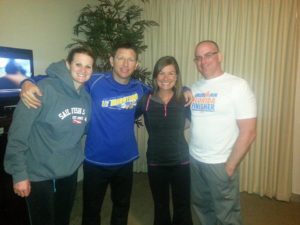 Jamie was the heroine of the night. When she decided to run she end up fast enough to finish with a 13:50. I am still so proud of her. Pete ended up a little under 15 and I ended up with a 15:09. I am not happy with it. It is significantly longer than 2011, but I finished and everything considered, I did have fun. That is what matters most.
Jamie was the heroine of the night. When she decided to run she end up fast enough to finish with a 13:50. I am still so proud of her. Pete ended up a little under 15 and I ended up with a 15:09. I am not happy with it. It is significantly longer than 2011, but I finished and everything considered, I did have fun. That is what matters most.
Thank you to all who tracked and reported on Facebook, for all the prayers, thoughts, motivation and kudos, Anne, Kari, Maria, Hugo and all the other voluneteers, Kim for supporting me and especially to Pete, Jamie, & Kat for being my training buddies through this journey.
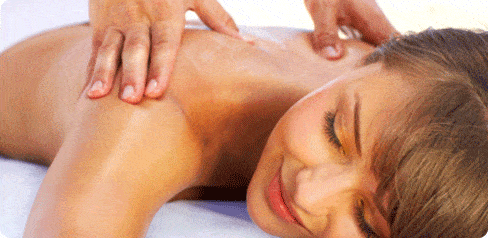
Easy Exercises to Keep You Active
Of course, you know you should eat right and exercise. Most everyone understands the importance of fitness for health. Why is it so hard to stay motivated then? Consider the things that inspire you toward fitness. You may enjoy a particular healthy recipe or be a fan of a certain professional athlete. You might have a goal of running a race or participating in a certain sporting event.
The primary benefit of sports massage is to improve blood to the muscles. Sports massage is a highly effective healing technique also moves oxygen and nutrients to muscles. After you exercise, lactic acid builds up in the muscles. Sports massage can eliminate lactic acid buildup. You can decrease your recovery time by simply eliminating lactic acid buildup and improving the flow of lymphatic fluids. This process promotes the healing process (http://www.howtobefit.com/massage-for-runners.htm).
Consider these tips and methods of sports massage from the Pro academy of New York golf course, Shenandoah:
Frozen Water Bottle – Most athletes are familiar with the concept of rest, ice, compression and 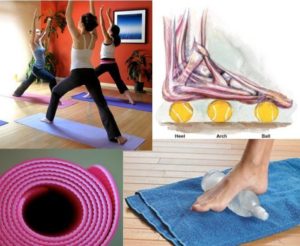 elevation (RICE). A frozen water bottle is an affordable way to ice the muscles and massage them at the same time. The ice will reduce the swelling and soothe your extremities as you roll your muscle with the water bottle. Consider this low-cost at-home massage remedy after your workout.
elevation (RICE). A frozen water bottle is an affordable way to ice the muscles and massage them at the same time. The ice will reduce the swelling and soothe your extremities as you roll your muscle with the water bottle. Consider this low-cost at-home massage remedy after your workout.
Tennis Ball – If you don’t need the ice, try a tennis ball to massage your muscles. Tennis balls can also be used on the back and legs also. This method is effective for working out the knots in the foot. You can roll the feet over the tennis ball from toe to heel for the most effective results.
Soup Cans – Soup cans are also used to massage the feet and legs. Consider rolling your feet over cans or rolling the cans over your legs to relieve tension and pain. As the pain dissipates from the area of the body
where the soup cans are applied, recovery will begin. This will prepare you for your next workout session.
PVC Pipe – this is an inexpensive alternative to foam rollers. 10″ pipe is best and it is easy obtained from your local Home Depot or Loews. If a little cushion is needed the pipe can be wrapped in several layers of contact paper and secured with duct tape. You can then use it to massage your calves, hamstrings and even you lower and upper back just by rolling on it. It will easily break up the toxins that are located within the muscle and allow them to pass through the membrane and out through the endocrine system.
Training is Better With Sports Massage
There is nothing better than a nice sports massage to start the healing process. Most athletes have made the massage a part of marathon training. Certainly, the benefits of these massages have been proven. Consider sports massage for less painful and more effective training. A healthy life is easy with simple changes. Take baby steps. Remember that moderation is key in all things. Indulge from time to time, but treat the body as the precious temple that it is. When setting your health goal start small. Choose a goal
that is attainable and reasonable.
(This was written by Michelle Pino with some added content by the IronGoof specifically for IronGoof.Com)
There have been so much I have been wanting to write about, but my time has been taken up by this thing I have to do called “a job”. Do any of you out there have this same problem? It is really starting to get in the way of my training, coaching and especially my blogging. I cannot believe how long it has been since I have posted something, and it is a crime with all the ideas that have been flying around in my head.
Let me use this post as a way to get back into the habit of blogging daily or at least a few times a week. Subject – The Off Season.
 I have been toiling with this for the past month just because I have been finding myself not working out a little less than normal. When I do, I am enjoying lower durations with small bursts of high effort, a.k.a intervals. As I speak with some of my fellow cohorts in triathlon I have been getting two primarily different opinions. One is coming from the die-hards, “Off season?? What off season? There is NO off-season!”, the other is coming from most of the guys that actually take podiums, but have more time to train during race season. “Dude, you have to come down a bit and give your body a rest. You have been putting it through a lot of stress. Trust me bro, you will have a better race season if you slow down a bit and take some rest.” So, what does a guy in my position do? I want to improve, but my philosophy is all about injury prevention.
I have been toiling with this for the past month just because I have been finding myself not working out a little less than normal. When I do, I am enjoying lower durations with small bursts of high effort, a.k.a intervals. As I speak with some of my fellow cohorts in triathlon I have been getting two primarily different opinions. One is coming from the die-hards, “Off season?? What off season? There is NO off-season!”, the other is coming from most of the guys that actually take podiums, but have more time to train during race season. “Dude, you have to come down a bit and give your body a rest. You have been putting it through a lot of stress. Trust me bro, you will have a better race season if you slow down a bit and take some rest.” So, what does a guy in my position do? I want to improve, but my philosophy is all about injury prevention.
Looking at the science of it I came up with the following opinion (notice I said opinion?):
Working out is cumulative – everything you do to a muscle repeatedly continues to impact it no matter what you are doing. Why do most marathon training plans have the mileage go up for 3 weeks and then dramatically falls the 4th week? The quadriceps hamstrings, calves, have taken a beating for three weeks and they need time to recuperate. The fibers of the muscle need time to repair, but if they keep being taxed then they stretch and start to heal they are taxed again. Even though they have started the healing process, they cannot fully heal unless they are put at rest for a significant amount of time. Yes, with proper nutrition, and preemptive injury therapy the healing can be expedited to a point, but they surely will not heal completely unless they are at rest.
Running everyday for 15 days in a row no matter how much the workouts change from slow to fast twitch muscles and back again, put a cumulative toll on your body. Now put that in perspective of a triathlete’s season that starts with base workouts in late January and doesn’t end until late October early November. That is 10 months of a cumulative toll on the body, whether you are an age grouper or pro. Do you think with that kind of wear and tear on the body that if there isn’t a slow down in the frequency and a lowering of the effort level that there might be some injuries awaiting or at least some backsliding in the coming racing season? I do.
Fact: It takes even a pro marathoner 20 days to fully recuperate from a race. 26.2 hard miles on the body of a fully trained marathoner, still takes a long time to recuperate doesn’t it? What do you think that does to an age grouper?
I am going to take this month as it comes. I am going to do a few races, and if I don’t feel like working out when the alarm goes off, so be it. When January comes I’ll be doing my base mileage and continuing my strength and flexibility training as planned, but when February 1st comes…..IT”S ON!!!!!